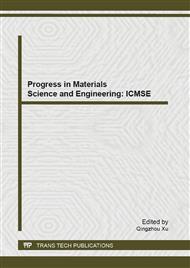[1]
Sivakumar M, Manjubala I. Mater Lett 50 (2001) 199–205.
Google Scholar
[2]
Kumar R R, Wang M. Mater Lett 55(2002) 133–7.
Google Scholar
[3]
Wang J, Chao Y L, Wan Q B, Zhu Z M, Yu H Y. Acta Biomaterialia 5 (2009) 1798–1807.
Google Scholar
[4]
D S Brauer, et al. Acta Biomaterialia 68 (2010) 3275 –3282.
Google Scholar
[5]
Qu H B, Wei M. Acta Biomaterialia 2 (2006) 113–119.
Google Scholar
[6]
Wei M, Vellinga D, Leavesley D, Evans J, Upton Z. Key Eng Mater(2003)240–242;671–674.
Google Scholar
[7]
Li T T, Lee J H, Kobayashi T, Aoki H. Mater Sci-Mater Med (1996) 355–357.
Google Scholar
[8]
Milev A, Kannangara GSK, Ben-Nissan B. Mater Lett 57 (2003) 1960–5.
Google Scholar
[9]
Stoch A, Brozek A, Kmita G, Stoch J, Jastrzebski W. Mole Struct 596 (2001) 191–200.
Google Scholar
[10]
Jalota S, Bhaduriand S B, Tas A C. Mater Sci Eng C 27 (2007) 432–40.
Google Scholar
[11]
Hamdi M, Hakamata S, Ektessabi A M. Thin Solid Films 484 (2000) 377–378.
DOI: 10.1016/s0040-6090(00)01276-1
Google Scholar
[12]
Bao Q, Chen C, Wang D, Ji Q, Lei T. Appl Surf Sci 252 (2005) 1538–1544.
Google Scholar
[13]
Xue W, Tao S, Liu X, Zheng XB, Ding C. Biomaterials 25 (2004) 415–421.
Google Scholar
[14]
Weng J, Liu XG, Li XD, Zhang XD. Biomaterials 16 (1995) 39–44.
Google Scholar
[15]
Cheang P, Khor KA. Biomaterials 17 (1996) 537–544.
Google Scholar
[16]
F. Lusquiños. Journal of Materials Science: Materials in Medicine, 13 (2002) 601-605.
Google Scholar
[17]
F. Lusquiños, J. Pou, M. Boutinguiza, F. Quintero, R. Soto. Appl Surf Sci 247 (2005) 486–492.
Google Scholar
[18]
Zhu WD, Liu QB, Zheng . Journal of Biomedical Materials Research Part A, 11 (2008) 429–433.
Google Scholar
[19]
Min Z, Ding F, Xiu KL, Wen FL, Qi BL, Jian BZ. Appl Surf Sci 255 (2008) 426–428.
Google Scholar
[20]
Deng C, Wang Y, Zhang YP. Journal of iron and steel research international 4(2007) 73-78.
Google Scholar
[21]
Wang DG, Chen CZ, Ma J, Zhang G. Colloids and Surfaces B: Biointerfaces 66(2008) 155–162.
Google Scholar
[22]
Wang DG, Chen CZ, Ma J, Lei TQ. Appl Surf Sci 253 (2007) 4016–4020.
Google Scholar
[23]
Cheng G J, Pirzada D. Materials Science and Engineering C 25 (2005) 541 – 547.
Google Scholar
[24]
Cheng G J, Ye C. Journal of Biomedical Materials Research Part A. 1 (2010) 70–79.
Google Scholar
[25]
Wei M, Vellinga D, Leavesley D, Evans J, Upton Z. Key Eng Mater (2003) 240–242; 671–674.
DOI: 10.4028/www.scientific.net/kem.240-242.671
Google Scholar
[26]
Sundfeldt M, Widmark M, Wennerberg A. Mater Sci Mater Med 13 (2002) 1037–43.
Google Scholar
[27]
Wang YC, Li YM, Yu HL, Ding JJ. Surface & Coatings Technology 200 (2005) 2080 – (2084).
Google Scholar
[28]
Lau K, Goodwin C, Arias M, Mohan S, Baylink DJ. Bone 30 (2002) 705–711.
Google Scholar
[29]
Harrison J, Melville AJ, Forsythe JS, Muddle BC. Biomaterials 25 (2004) 4977–4986.
Google Scholar
[30]
Kim HW, Lee EJ, Kim HE, Salih V, Knowles JC. Biomaterials 26 (2005) 4395–4404.
Google Scholar
[31]
Okazaki M, Miake Y, Tohda H, Yanagisawa T. Biomaterials 20(1999) 1421–1426.
DOI: 10.1016/s0142-9612(99)00049-6
Google Scholar
[32]
Gross KA, Rodriguez-Lorenzo LM. Biomaterials 25(2004) 1385–1394.
Google Scholar
[33]
Lugscheider E, Knepper M, Heimberg B. Mater Sci Mater Med 5 (1994) 371–5.
Google Scholar
[34]
Wang H, Eliaz N, Xiang Z, Hsu HP, Spector M, Hobbs LW. Biomaterials 27(2006)4192–203.
Google Scholar
[35]
Zhang S, Xianting Z, Yongsheng W, Kui C, Wenjian W. Surf Coat Tech 200 (2006) 6350–6354.
DOI: 10.1016/j.surfcoat.2005.11.033
Google Scholar
[36]
Barinov SM, Tumanov SV, Fadeeva IV, Bibikov VY. Inorg Mater 39(2003)877–880.
DOI: 10.1023/a:1025041817017
Google Scholar
[37]
Lee JH, Ryu HS, Lee DS, Hong KS, Chang BS, Lee CK. Biomaterials 26 (2005) 3249–3257.
Google Scholar
[38]
Rokusek D, Davitt C, Bandyopadhyay A. J Biomed Mater Res 75A (2005) 588–594.
Google Scholar
[39]
Gough JE, Notingher I, Hench LL. J Biomed Mat Res A 68A (2004) 640–50.
Google Scholar
[40]
Suzette I, Faleh T, Robert M, Damien LN. Acta Biomaterialia 5 (2009) 2338–2347.
Google Scholar
[41]
Hench LL, Wilson J. An introduction to bioceramics. Singapore: World Scientific; (1993).
Google Scholar


